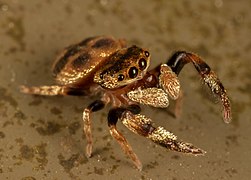Biology:Irura bidenticulata
| Irura bidenticulata | |
|---|---|

| |
| Male | |

| |
| Female | |
| Scientific classification | |
| Domain: | Eukaryota |
| Kingdom: | Animalia |
| Phylum: | Arthropoda |
| Subphylum: | Chelicerata |
| Class: | Arachnida |
| Order: | Araneae |
| Infraorder: | Araneomorphae |
| Family: | Salticidae |
| Subfamily: | Salticinae |
| Genus: | Irura |
| Species: | I. bidenticulata
|
| Binomial name | |
| Irura bidenticulata (Guo, Zhang & Zu, 2011)
| |
Irura bidenticulata, commonly known as the purple-gold jumping spider, is a species of salticid. As the name implies, while females tend to take on a more dull coloration, males are characterized by their striking, shiny magenta-gold patterned bodies. Discovered in 2011, the spider had initially been mistaken for a member of the Simaetha genus. Native to regions of Southeast Asia, it was first spotted in Hainan, China, having since also been located in the Saraburi province of Thailand, Cambodia, Hong Kong, and Assam.[1][2][3][4]
Description
The purple-gold jumping spider typically measures 5–6 mm (0.20–0.24 in).[5] It is sexually dimorphic; most females of the species are of an almost solid gold pigmentation (though some may exhibit a muted brown pattern resembling that of a male), while males are known for their dazzling purple-pink and gold patterned reflective trichobothria. The unique purple pattern on males' abdomens best described as "a snow angel wearing a tophat" surrounded by gold coloration tends to remain the same. However, the purple-gold pattern on the top of their heads often varies slightly between individuals, as do their pedipalps. The cheliceras are occasionally black-tipped, in addition to the base of the extremities.
Gallery
References
- ↑ "Irura bidenticulata" (in en-US). https://www.inaturalist.org/taxa/838255-Irura-bidenticulata.
- ↑ "First records of the jumping spider genus Irura". 14 August 2021. https://peckhamia.com/peckhamia/PECKHAMIA_243.1.pdf.
- ↑ Kropf C., Nentwig W., Blick T. & Gloor D. (organizing board). (2019). WSC: World Spider Catalog (version 19.5, Jan 2019). In: Species 2000 & ITIS Catalogue of Life, 2019 Annual Checklist (Roskov Y., Ower G., Orrell T., Nicolson D., Bailly N., Kirk P.M., Bourgoin T., DeWalt R.E., Decock W., Nieukerken E. van, Zarucchi J., Penev L., eds.). Digital resource at www.catalogueoflife.org/annual-checklist/2019. Species 2000: Naturalis, Leiden, the Netherlands. ISSN 2405-884X.
- ↑ Dmitri, Logunov. "On four species of Irura Peckham & Peckham, 1901 (Araneae: Salticidae) collected by John and Frances Murphy from south-east Asia". https://www.researchgate.net/publication/361265103_On_four_species_of_Irura_Peckham_Peckham_1901_Araneae_Salticidae_collected_by_John_and_Frances_Murphy_from_south-east_Asia.
- ↑ Guo, J. Y., Zhang, F., Zhu, M. S. (2011) Two new species of the genus Irura Peckham & Peckham, 1901 (Araneae: Salticidae) from Hainan Island, China, Acta Arachnologica 60: 89-91
Wikidata ☰ Q27504710 entry
 |





